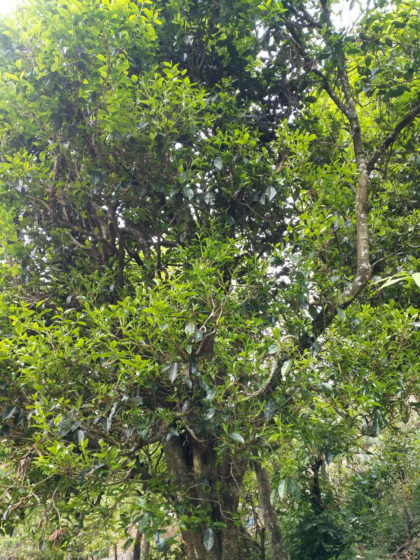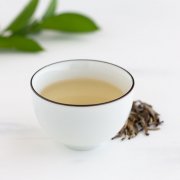What is the difference between tree tea and tree tea? What are the characteristics and benefits of ancient tea?
In the modern tea world,"wild tea tree" is a huge controversy. More and more tea merchants are using the mysterious charm of wild tea trees as a marketing strategy. As a result, more tea lovers are beginning to believe that these teas are not real teas. Most ancient tea trees grow in Yunnan Province, China. Yes, Pu 'er area! Without cultivation, they can stretch anywhere from 5 to 10 meters high, which makes tea difficult to harvest. What makes wild leaf tea so unique and popular? First of all, we want to emphasize that there is absolutely nothing wrong with growing tea. Tea has been cultivated for thousands of years. Thanks to the hard cultivation and hard work of tea farmers for a long time, we can taste a wide variety of tea leaves with different aromas. Although it is the processing method that ultimately forms a tea, the role of variety is undeniable. The appeal of wild tea is that it cannot do what cultivated tea can do. Cultivated tea gives us consistent results. They give us the flavor we crave. We believe we all have our favorite teas, and we stock up on them-expecting that wonderful taste we're always used to! Wild tea is unpredictable. It was an extraordinary journey into the unknown. No one knows what we will get. The taste of a single batch of wild tea is complex and unmatched.

What does wild tea mean? Wild tea is not just tea plucked from an unattended tea plant. It can refer to several different teas, each with its own "wild".·Ancient tea trees These tea trees have been neglected and uncultivated for hundreds of years and have been for generations. They grow widely throughout China. Whether they were ever bred is a matter of debate, but now they are wild. These tea trees are sought after by tea farmers and are not easy to find. Tea fans often go forage hiking in search of these undiscovered tea trees.·Forest tea trees These tea trees are almost wild. Although ancient tea trees were rare, some tea masters chose to grow their tea trees in the "wild." This means planting tea trees more or less in the forests of China, rather than maintaining their unity in tea gardens. These tea trees are usually allowed to grow freely, without the use of pesticides, etc. They eventually produce a distinctive taste similar to that of ancient tea trees.·The farmers planted these tea trees in more or less consistent rows, similar to a typical tea garden. The most striking difference is that they were deliberately allowed to grow in the wild, developing their inconsistent characteristics. Biodiversity prevails, and tea develops unique flavors, layers and depths more widely. These tea plantations are really difficult to navigate because the tea trees don't grow neatly. Tea is also harder for farmers to pick.·Most of the natural trees are cuttings, and the number of natural trees is still very low. Natural seeding is a slow process, and such tea plants do not produce the "safe" and stable results that farmers can get from planting tea trees. However, these tea trees are an important part of the "tea will" industry, producing interesting and delicious teas. Growing tea through cuttings can be compared to cloning and genetic engineering versus natural sowing. Producing tea from these wild plants undoubtedly requires more work (gathering, hard picking and travelling all added up). The higher price is reasonable. However, this does not mean that wild tea can be purchased just because of the label. It is important to remember that besides the tea tree being wild, it should also be sustainably sourced (without damaging its natural environment) by tea masters and handled with skill and care. We encourage you to buy tea, not exactly based on the label, but to make sure you buy tea from a trusted and knowledgeable tea supplier. Here are some of the benefits of drinking wild tea: Tea made with ancient tea trees does not contain any pesticides that are sometimes present in traditional tea gardens (unless you buy organic tea). Their wild environment and strong roots mean that they are usually more nutritious than cultivated teas, and the taste of ancient teas is more complex and unique, and you will never find tea like it again. Some tea lovers even believe that the value of tea increases with age
Important Notice :
前街咖啡 FrontStreet Coffee has moved to new addredd:
FrontStreet Coffee Address: 315,Donghua East Road,GuangZhou
Tel:020 38364473
- Prev

What is the difference between the colors of authentic black tea? How to tell whether black tea is dyed or not?
Recently I went to a teahouse. Their tea is not classified by category, black tea, oolong tea, green tea and so on, as in most places, but according to the degree of baking. Deep baking, medium baking, and light baking. Of course, they do not cover all tea categories. Only black tea, oolong tea and green tea, but this concept introduces
- Next

The first offline concept store in Shanghai will open soon! Advantages and characteristics of boutique coffee concept store
In June, the boutique coffee brand completed a new round of financing of hundreds of millions of yuan with a valuation of 4.5 billion yuan. After nearly three months, the three-and-a-half offline concept store finally landed in Shanghai. The new store is called Force Flying into the force, which is similar to the three-and-a-half-meal exploration of planetary culture. The offline store is a three-and-a-half meal adventure into the new world, and it may also be a three-and-a-half-meal brand.
Related
- What ratio of water temperature and ground does the smart cup method use to press coffee? The difference between brewed coffee and filtered coffee?
- What is the standard process for the purpose of coffee cup testing? What is the difference between hand-brewed coffee and cup testing?
- How to use hand-brewed coffee paragon small golden balls? How does cold coffee lock in the aroma of coffee?
- Is American coffee black? What is the difference between American coffee and drip coffee?
- Unexpected! Well-known tea beverage brand Lele Tea will withdraw from the Zhengzhou market!
- Starbucks enters the fashion and beauty industry?! Netizen: Give me an ice American eye cream
- Why can American refills for free? The difference between Americano and American drip pot coffee
- Being chased out of the rain in front of Starbucks?! Store: Sheltering from rain under umbrellas poses a safety hazard
- The white moonlight has changed?! Lucky launches "Big Winter Pear American"
- Hand-brewed coffee three-stage method, high-sweet and universal brewing method to share! What does the high sweet water level of hand-brewed coffee mean?

